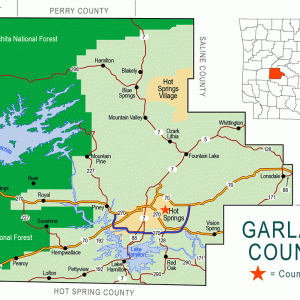calsfoundation@cals.org
White Sulphur Springs (Garland County)
White Sulphur Springs was a resort area in Garland County constructed close to a number of mineral springs near the southern slope of Indian Mountain. The area eventually became part of Hot Springs (Garland County).
The earliest residents of the area were Native Americans. Novaculite located on the west end of Indian Mountain was useful to them. Early white settlers of the area arrived in the 1820s and established a small community along Gulpha Creek. The ruggedness of the area made large-scale agriculture impossible, but small-scale farms were successful. The Houpt family constructed a grist mill next to the creek in 1827. Novaculite quarries on the south side of the mountain provided early settlers with a ready supply of the rock, which was used as a whetstone and for other purposes.
The two earliest land patents in the area were awarded on June 1, 1882: William Wells obtained 120 acres, while Samuel Wesley Fordyce received eighty.
John Gillen arrived in Hot Springs in 1870. The New York–born son of Irish immigrants, Gillen worked in Louisiana and Little Rock (Pulaski County) before moving to Garland County. After operating a restaurant for a few years, he privately purchased 140 acres of land in the 1880s. He also obtained a land patent for eighty acres on August 30, 1882. The land includes five cold-water springs: Sweet, Iron, Sour Rock, Mountain, and White Sulphur.
Gillen and his business partner, Gus Belding, constructed the large Victoria Hotel on the site, which began to attract tourists who traveled to the county to receive treatment in the waters of the hot springs. Many spent a month bathing in the hot springs before using the waters in the cold springs for another two weeks. The remoteness of Gillen’s hotel also enticed visitors who wished to avoid the often crowded and dirty areas surrounding the bathhouses in Hot Springs. The two-story hotel included a full-length wrap-around porch on the first floor and wrap-around second-floor balcony. Gillen constructed a gazebo over one of the springs, using natural stone and mortar to enclose the flow of the water and allow visitors to access it more easily.
Gillen began drilling in the nearby mountain in 1890 to reach a supposed hot water spring, but the effort failed. He also bought out his partner, Gus Belding, around this time. References to the business became more infrequent, and the hotel closed at an unknown date in the early twentieth century. The buildings fell into ruin. Hubert Echols purchased the property at auction and demolished the buildings on the site, using some materials from the hotel to construct a home.
White Sulphur Springs serves as a residential area on the northeast edge of Hot Springs. The site of the Victoria Hotel is located about half a mile northeast of the Magic Springs theme park. The stone and mortar structure over the spring remains and is the last physical evidence of the resort. The Echols family still owns much of the property in the twenty-first century.
For additional information:
Anthony, Isabel. Garland County, Arkansas: Our History and Heritage. Hot Springs, AR: Garland County Historical Society, 2009.
———.“John Gillen’s White Sulphur Springs and Victoria Hotel.” The Record 50 (2009): 25–32.
Arkansas Archeological Survey. “Arkansas Novaculite: A Virtual Comparative Collection.” http://archeology.uark.edu/novaculite/index.html (accessed February 9, 2021).
David Sesser
Henderson State University
 Garland County Map
Garland County Map 




Comments
No comments on this entry yet.